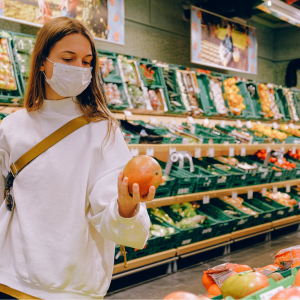
This study surveyed people from 119 countries about their experiences of food environments and food acquisition practices during the early stages of the COVID-19 pandemic (April 2020). Many respondents experienced physical distancing requirements at food shops (90% of respondents), restricted access to stores (77%), stockpiling foods (67%), increased awareness of food waste (63%) and buying more food due to fear or anxiety (47%).
The authors propose ten policy “entry points” which could promote resilient food environments by building on changes in consumer behaviour shown in the pandemic. These are illustrated below.
Image: Figure 4, O'Meara et al. Ten policy entry points (blue hexagons) to build more resilient food environments and harness positive dietary-related behaviors manifested through the pandemic, mapped to the external and personal food environment domains.
Abstract
This study investigates consumer experiences of food environments and food acquisition practices during the Covid-19 pandemic. Our rapid assessment online survey featured a convenience sample of 2015 individuals from 119 countries, spanning Western Europe, North America, Latin America, Asia-Pacific, and Africa. Data collection took place in April 2020 during the second month of the pandemic. Participants were recruited via existing networks of the United Nations System Standing Committee on Nutrition, through social media, and by snowballing. The majority of participants were female (71.9%), from low- and middle-income countries (51.0%), and working in nutrition or healthcare (39.3%). Qualitative thematic analysis and descriptive statistics reveal a series of common global experiences related to food availability and accessibility, food prices and affordability, food acquisition practices, and food preparation and consumption. The importance of community food participation, food sharing, and resource allocation are highlighted, along with increasing awareness of healthy diets and food waste. We identify ten synergistic policy entry points to: 1) build resilient and equitable food environments resistant to stresses and shocks; 2) harness positive dietary-related behaviors manifested during the pandemic; and, 3) mitigate the projected nutrition crisis and promote sustainable healthy diets for all.
Reference
O'Meara, L., Turner, C., Coitinho, D.C. and Oenema, S., 2022. Consumer experiences of food environments during the Covid-19 pandemic: Global insights from a rapid online survey of individuals from 119 countries. Global food security, 32, p.100594.
Read the full paper here. See also the TABLE explainer What is the connection between infectious diseases in humans and livestock?







Post a new comment »